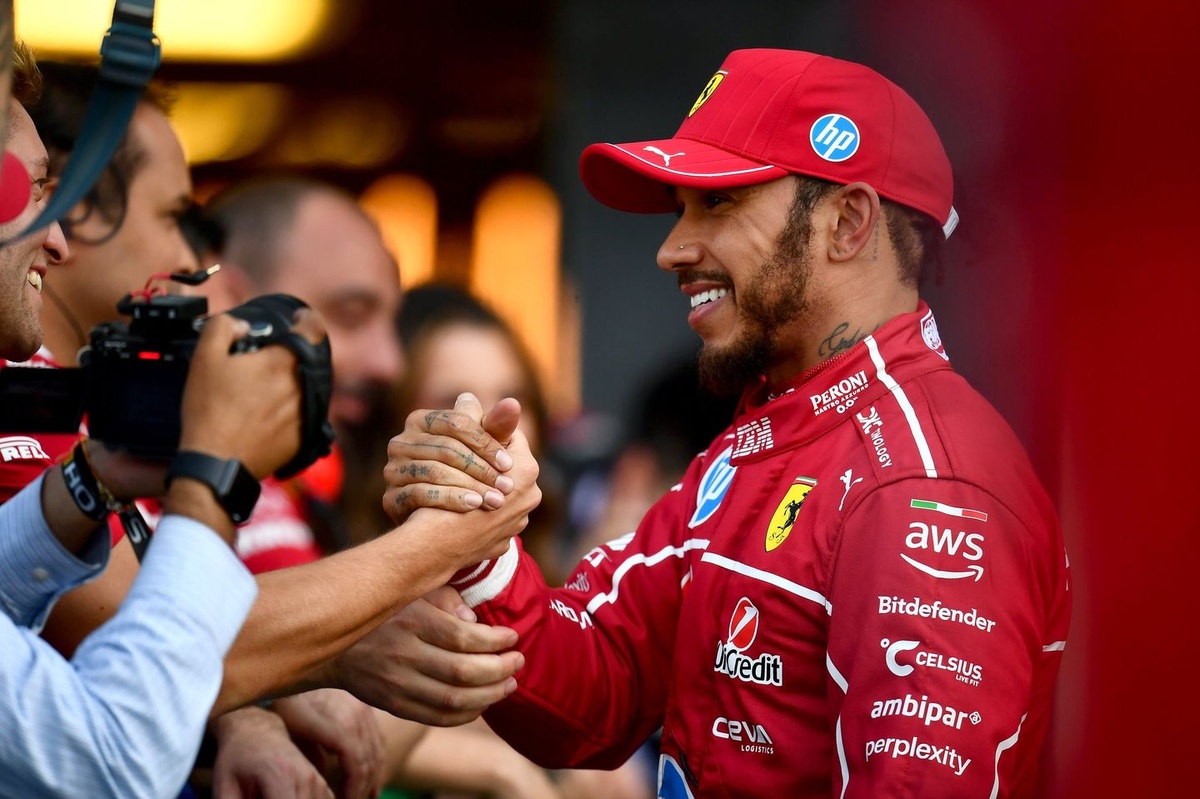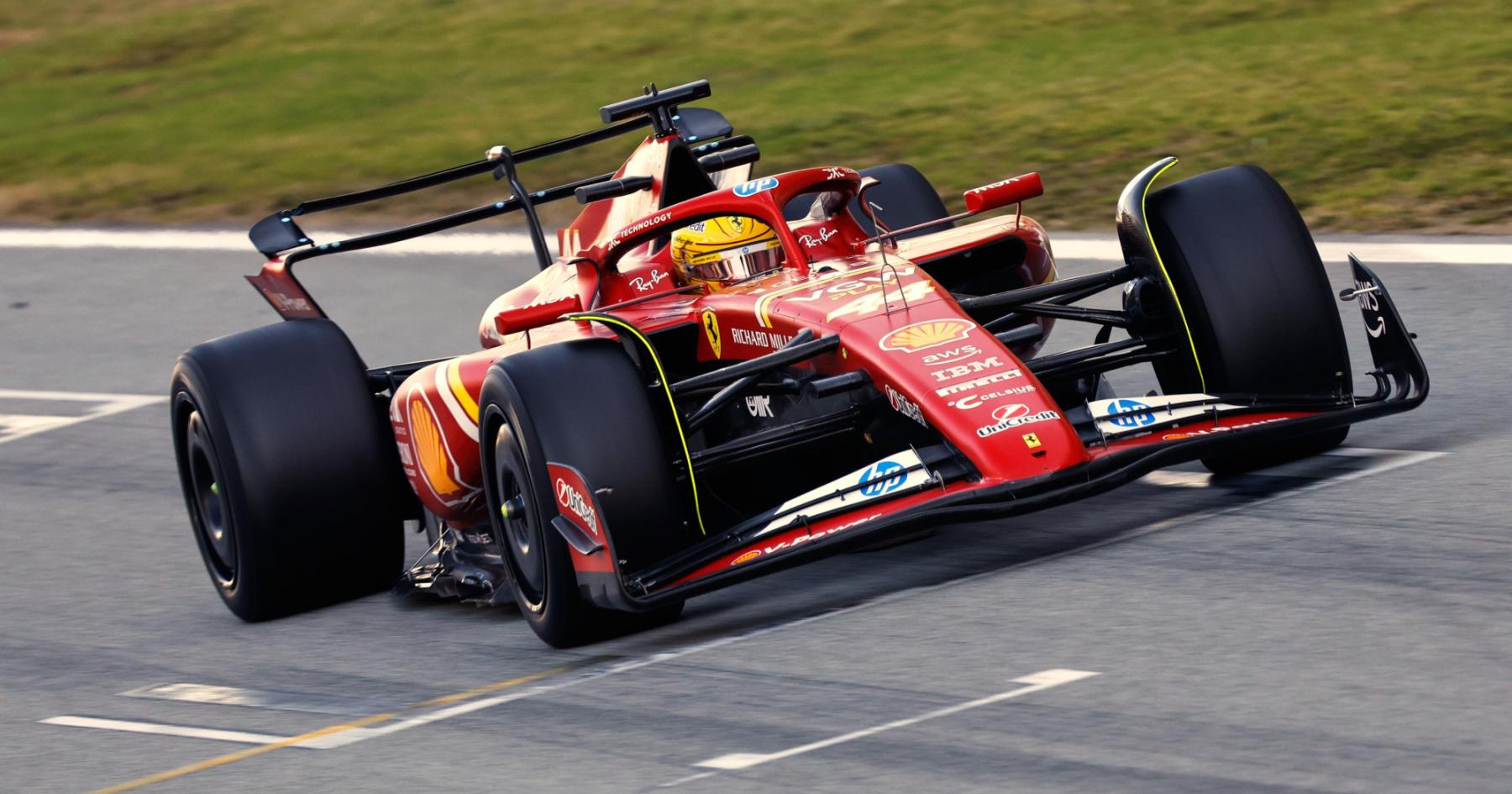The script for a Friday night in Las Vegas, particularly one plagued by freezing temperatures and a slippery, green track surface, usually ends in frustration. Drivers emerge from their cockpits shaking their heads, complaining of zero grip, graining tires, and interrupted rhythm. When you add a series of red flags and yellow flags that decimate every attempt at a qualifying simulation, you expect the mood in the garage to be somber, if not outright volatile.
Yet, when Lewis Hamilton stepped out of his Ferrari SF25 after a chaotic practice session under the neon lights of the Strip, he wasn’t fuming. He wasn’t throwing his gloves down in disgust or offering the media a standard, robotic PR response about “work to do.”
He was smiling.
And we aren’t talking about the polite, media-trained grimace drivers wear when they are trying to hide a disaster. This was a genuine, energized smile—the kind that tells engineers, rivals, and the watching world that something significant has just happened. Against all odds, and beneath the surface of a messy timesheet, the seven-time world champion discovered a spark in the Ferrari SF25 that has effectively flipped the mood inside Marinello from anxiety to electrifying belief.

The Chaos That Hid the Diamond
To understand the gravity of Hamilton’s reaction, you have to understand the conditions. Las Vegas on a Friday is brutal. The asphalt, cold and slick as sheet ice, is a nightmare for Formula 1 machinery. Getting heat into the tires is the primary directive, and failure to do so results in embarrassing spins and lost lap time.
Hamilton’s session was, on paper, a disaster. He didn’t manage to complete a single clean flying lap on the soft tires—the rubber designed for maximum grip. Every time he bolted them on and prepared to push, a yellow flag or a red flag stoppage forced him to abort. For a driver of his caliber, constantly having your rhythm broken is usually the recipe for a dark mood.
But while the screens showed interrupted laps, Hamilton’s internal sensors were picking up something else entirely.
“The car felt stable, predictable, and incredibly positive,” Hamilton revealed to a stunned media pen.
It was a statement that made every ear in the paddock prick up. In a sport dominated by data, driver feel is the final verification, and Hamilton was describing a sensation he seemingly hasn’t felt all season long. He wasn’t fighting the car; he was dancing with it.
The Medium Tire Magic
The real bombshell, however, lay in the details of his run plan. Since his soft tire runs were ruined by circumstances, Hamilton’s best data came from the medium compound tires.
Historically, and certainly throughout this season, Ferrari has struggled to switch on harder compounds in cold conditions. The SF25 has often been a diva, refusing to generate the necessary heat to bite into the asphalt unless conditions were perfect. But in the freezing desert air, Hamilton found the car was not only working on the mediums—it was thriving.
He reported that the car was generating heat, rotation, and traction immediately. If the SF25 can perform this well on a harder tire in the worst possible conditions for tire warm-up, the implications for the soft tire—and qualifying pace—are staggering. It suggests a massive reservoir of untapped potential that the rest of the grid hasn’t even seen yet because Hamilton never got to show it.
This wasn’t just a “good day.” This was Ferrari stumbling upon a setup window they have been hunting for months, hidden from the public eye by the chaos of the session.

The McLaren Comparison: A Warning Shot
Hamilton didn’t stop at general praise. He got specific, and when a driver like Lewis Hamilton gets specific, it’s worth paying attention. He directly compared the SF25’s behavior out of slow corners to the McLaren, a car that has been the benchmark for traction and driveability recently.
He noted that the Ferrari’s power delivery and traction out of the slow, technical sections felt better than the McLaren’s. In Las Vegas, where the lap is essentially a series of drag races following tight 90-degree turns, traction is king. If Ferrari has the edge on exit, they have the edge on the straights, and that is where the race will be won or lost.
“I Don’t Want to Change Anything”
Perhaps the most shocking part of Hamilton’s debrief was his reluctance to tinker. Formula 1 drivers are notorious perfectionists. They chase micro-adjustments, tweaking front wing angles by millimeters and playing with differential settings until the last possible second.
Hamilton, however, told his team he doesn’t expect to make many changes before qualifying.
“We’re not in a bad place. The pace was strong today. I’m excited for tomorrow,” he said.
Note the word choice: Excited. Not “hopeful,” not “cautiously optimistic.” Excited. For a veteran who has seen everything this sport has to offer, admitting excitement indicates a level of confidence that transcends hope. It suggests he knows he has a car capable of fighting for pole position, and he doesn’t want the engineers to mess it up by over-complicating the setup.

Leadership Beyond the Cockpit
Beyond the technical breakthroughs, Hamilton used his media availability to perform a vital act of leadership. Ferrari has been dogged by rumors of internal tension and pressure from the top, a narrative that loves to spiral out of control when results aren’t perfect.
Hamilton addressed this head-on, revealing that he speaks with Ferrari Chairman John Elkann several times a week. He firmly shut down rumors of a “blame culture” within the team, emphasizing shared responsibility and cohesion.
“There is no culture of blame,” he asserted.
In doing so, he didn’t just defend his team; he shielded them. He took the weight of the media narrative onto his own shoulders, allowing his engineers and mechanics to focus on the car rather than the headlines. This emotional intelligence is what separates a fast driver from a true team leader. He offered cohesion where the world wanted conflict.
The Verdict
As the sun rises over the Nevada desert and the teams prepare for the critical qualifying showdown, two scenarios lie ahead.
The first is that the track evolves, the temperatures shift, and this “magic window” closes as quickly as it opened—a story of what could have been.
But the second scenario—the one Hamilton seems to believe in—is that Ferrari has genuinely unlocked the SF25. If the car is this good on mediums, a clean lap on softs could see the Scuderia locking out the front row and dominating the race.
Hamilton’s smile wasn’t a mask. It was a signal. After a season of searching, the seven-time champion may have finally found the weapon he needs. And if he’s right, the rest of the grid should be very, very worried.